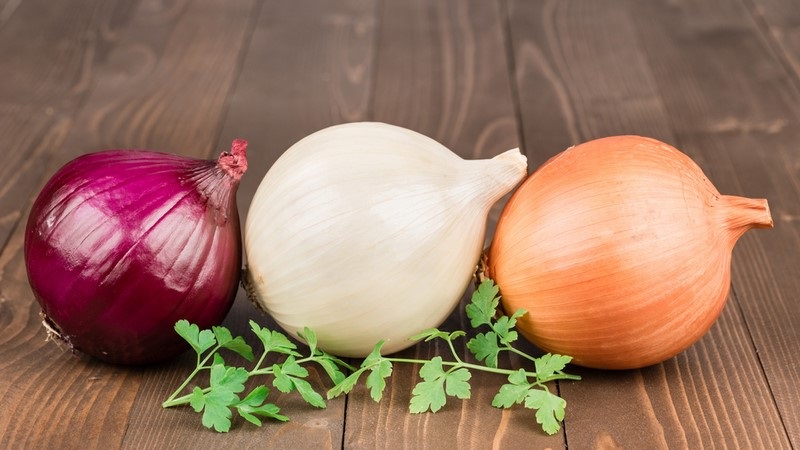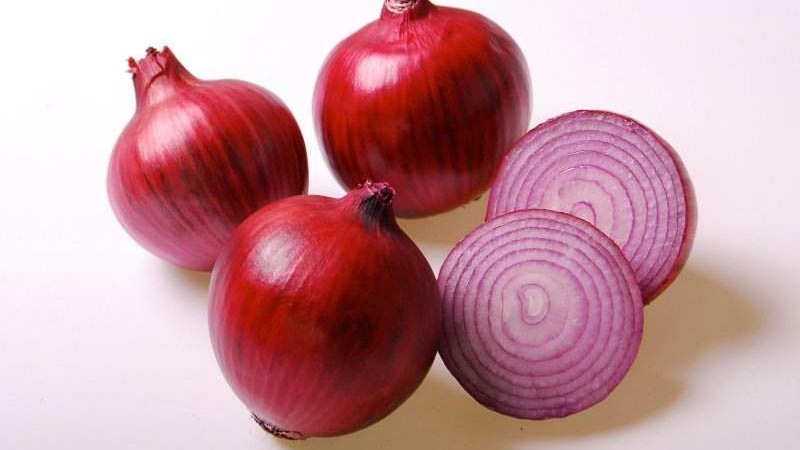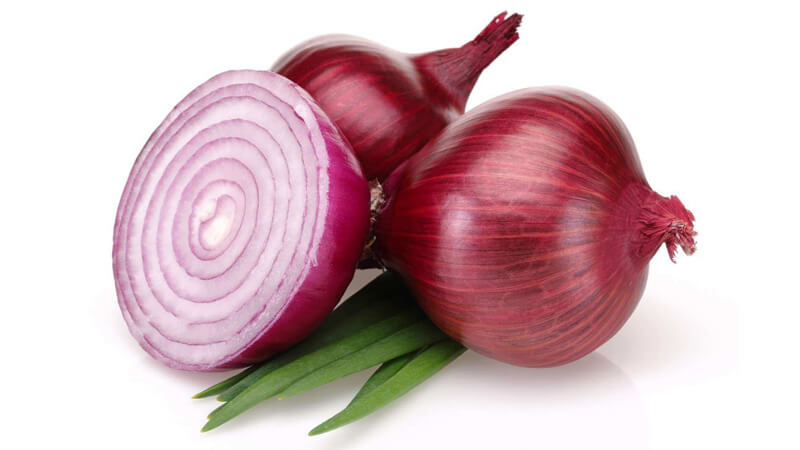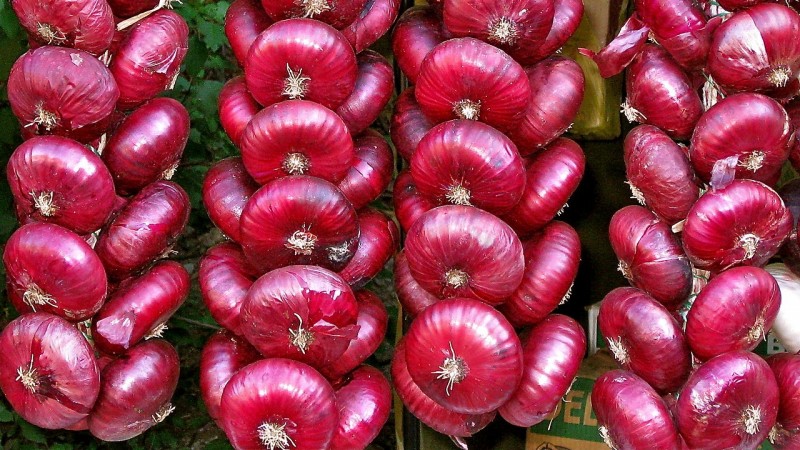Compare how red onions differ from ordinary ones and choose the best one
Onions are one of the healthiest and most commonly used culinary crops. Wherein varieties, differing from each other in shape, taste, useful properties and even color - hundreds. And if the taste of onions with golden scales is familiar to most, then white and red onions raise many questions: which of them is sweeter or sharper, are they suitable for conservation, raw salads and heat treatment, is there a difference in agricultural technology.
Read about all this and much more regarding the differences between red, white and ordinary onions in our article.
The content of the article
What is the difference between red and white onions
Onion heads differ in appearance, keeping quality, taste, composition and effect on the human body.
White onions have a neat spherical shape, creamy, snowy or grayish scales. The color of colored bulbs varies from lilac and burgundy tones to cold pinks, and the shape can be round, oblong or, conversely, flattened.
White varieties are more susceptible to rotting, and their shelf life does not exceed 10-12 weeks. Red bulbs are kept much longer - up to six months.
Reference! As for the calorie content, it is almost the same for all varieties and is: for a red vegetable 41-42 kcal per 100 g, for a white one - 45 kcal.

Differences in properties and composition
The chemical composition of any onion contains vitamins, essential oils, useful trace elements. However, the content of some of them may vary.
Table: The number of useful elements in red and white onions
| Name of substance | White bow | Red onion |
| Protein | 1.5 g | 1.4 g |
| Carbohydrates | 11 g | 9,1 g |
| Vitamin C | 10 mg | 10 mg |
| Riboflavin | 0.02 mg | 0.1 mg |
| Pyridoxine | 0.1 mg | 0.1 mg |
| Folic acid | 9 mg | 9 mg |
| Sulfur | 65 mg | 65 mg |
| Phosphorus | 58 mg | 27 mg |
| Calcium | 31 mg | 31 mg |
| Magnesium | 14 mg | 14 g |
In addition, white onions contain 0.1 mg of pantothenic acid and 0.5 mg of niacin. The purple-pink pulp contains vitamin E in an amount of 0.2 mg, thiamine - 0.05 mg, as well as chromium, zinc and iron in small amounts.
Reference. White onions have anti-inflammatory and antimicrobial properties. Its red counterpart also has antibacterial and immunomodulatory properties.
The difference in benefits and harms
Despite the fact that the composition of both varieties is similar, they affect the human body in different ways. Red "turnips", when consumed in moderation, can lower blood sugar levels. White pulp is effective in combating plaque cholesterol.
Reference! Excessive consumption of raw white onions - more than 200-300 g per day - can lead to increased blood pressure and stomach acidity.
What is the difference in taste and aroma

They also differ in taste.
White has a rich flavor (mild to tangy) with a slight sweetness. The usual onion bitterness is practically absent.
The heads of red vegetables, thanks to the varietal variety, have a completely different taste: from soft and sweet to scalding spicy and even bitter.
Reference! White onions are endowed with a bright and memorable aroma. The smell of red is lighter and, moreover, evaporates during heat treatment.
Comparison of the nuances of growing
Their cultivation is not much different. However, in red onions, the fibrous rhizome is deeper into the soil, and in white onions, the root system lies close to the surface of the earth.Therefore, it is necessary to loosen and water the seedlings of white varieties carefully, otherwise you can damage the fragile roots or cause their decay and death of the culture.
Features of the use of red and white onions
Onions are one of the healthiest vegetables that are actively used in cooking, folk medicine and cosmetology.
In cooking
White and purple varieties are actively used in cooking. Both varieties can be cooked, eaten raw and canned.
Red "turnips" with a light aroma are often used raw for fresh salads and snacks. White due to its rich odor, which does not evaporate when exposed to heat, is used for cooking first, second courses, sauces, as well as canning mushrooms, vegetables, white cabbage sourdough.
In folk medicine

Both varieties have bactericidal, antifungal and antioxidant effects and help fight infectious diseases. For example, in case of an inflammatory process in the ear, finely chopped white onions are wrapped in cloth and applied to the ear until the pain subsides.
When coughing and stagnation of phlegm in the bronchi, a paste from a crushed white or red onion is mixed with a few drops of coconut oil, spread on the chest with a compress and covered with a film and a towel.
Reference. To prevent ARVI, it is enough to consume 50 g of red or white onions for a month in the morning and evening.
Masks made from chopped white onions are used to treat acne. The gruel can be applied directly to the affected skin with a layer of about 2 mm for 10-15 minutes. To relieve inflammation and accelerate skin regeneration, it is recommended to apply a mask made from 30 g of grated onion mixed with the same amount of honey for a quarter of an hour, then rinse with warm water.
Indispensable onions in the fight against female and male diseases. In case of menstrual irregularities, onion peel infusion is taken in 100 ml twice a day for a week.
How to prepare a decoction:
- Mix 30 g of dried cloves and 90 g of red onion husks.
- Place the mixture in an enamel pot and pour 500 ml of filtered water.
- Bring to a boil over low heat. Boil for 10 minutes.
- Cool, drain.
White onion juice (200 ml) mixed with natural honey in a 1: 1 ratio will relieve prostatic hypertrophy. Take 30 g of the mixture for a month twice a day (morning and evening). Also, the vegetable is effective in the fight against worms.
The tool is prepared as follows:
- Chop 200 g red onion finely.
- Pour 200 ml of warm water.
- Leave the composition for 8 hours.
- Strain.
Take the infusion for five days early in the morning on an empty stomach.
The vegetable will also help with migraines. To do this, a white onion cut in half is applied to the temples and tightly secured with a bandage. To prevent headaches, the procedure is carried out twice a day for four days.
Red onions are needed to stimulate hair growth and prevent dandruff. Gruel (50 g) is rubbed into the hair roots once a week.
The chopped vegetable is recommended to be applied to the affected area of the skin for itching and pain from insect bites.
What bow and when to choose
The taste of red onions, depending on the variety, can be bitter, sweet, spicy and delicate. It is recommended to choose it for making salads, cold soups, snacks, etc. As an alternative, sweet varieties of white onions Globo, Comet are also suitable.
For adding to pies, hot dishes, canned food, it is preferable to choose spicy varieties and hybrids of white vegetables, for example, Bello Blanca F1, Alba.
For those with type 2 diabetes, it is recommended to eat red onions more often - it lowers blood sugar levels. White is advised to be consumed by the elderly, overweight - it is effective in the fight against cholesterol plaques.
What common
The main common feature of all varieties of onions is their health benefits due to their rich composition. Both red and white onions strengthen the immune system, but at the same time they can exacerbate diseases of the gastrointestinal tract, liver, heart and kidneys.
Reference! Both types of vegetables are not recommended to be added to food for children under two years of age due to the aggressive effect on the mucous membranes.
Which onion is healthier

Nutritionists believe that red onions are somewhat more usefulthan white. It contains more vitamins and useful trace elements, it helps with infectious diseases, in the treatment of wounds, burns, calluses and corns, hair loss and baldness.
Its regular use in moderation (no more than 200 g per day) stimulates the production of red blood cells and increases immunity, lowers sugar and cholesterol levels. It does not cause fluctuations in blood pressure and does not affect the cardiovascular system.
People often eat red vegetables fresh, which means they get more useful elements.
Conclusion
Whatever color the onions are, scientists and doctors confirm its colossal benefits for the human body. However, onions have a number of contraindications: high blood pressure, diseases of the gastrointestinal tract, heart, liver, age up to two years.
With caution, you should use onions during the period pregnancy and lactation.